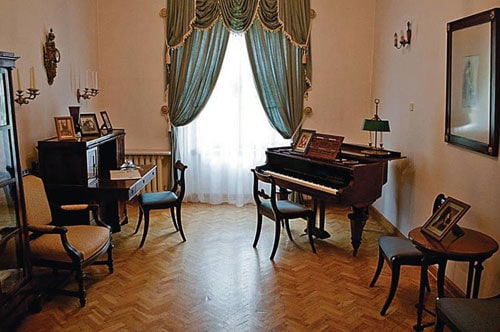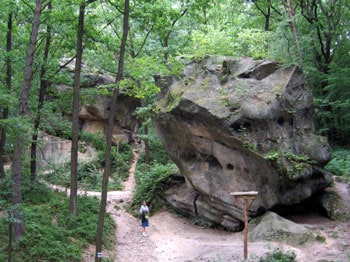

He died on June 29,1941, in New York City and was buried in Arlington National Cemetery. After the fall of Communism in Poland, Paderewski’s remains were returned to his native land in 1992.
Polish society is quite familiar with the music and political career of Ignacy Paderewski, who was called „the king of pianists” and „the second Chopin.” Numerous books were written about him and his involvement in the Polish political arena. It will be pointless to remind our readers these well-known facts. The goal of this article is to present a short episode from Paderewski’s life. The matter is only known to he narrow circle of Paderewski’s enthusiasts but was extremely important for the artist.

Paderewski’s mansion.
It was no secret to Paderewski’s friends that the composer really wanted to own a house in Poland that would be surrounded by fields of grain and whispering woods. The horizon would spread out far and wide. This dream came true in 1897, when the composer bought such an estate in Kasna Dolna, near Ciezkowice. He paid 130 thousand zloty for the property that included several small villages such as Bukowiec, Jamna and Siekierzyna. The total area consisted of 296 hectares of arable land and 780 hectares of forest. The place that the new owner chose not only was close to the Tatry but not far from Paris either. „It would take a little over 33 hours to get from Paris to Kasna if you took an express train and then ran two miles and then turned to the left and later to the right and went through the bridge…”
The town of Ciezkowice that almost blends with Kasna Dolna is worth mentioning. It is a picturesque town and it celebrated its 650th anniversary in 1998. In the same year, the town regained its city status. The town is located in the region of Pogórze Karpackie 280 meters above the sea level. Currently the town Ciezkowice belongs to the Tarnów county and it is part of Malopolska province.
The artist was full of admiration for the classicist country house of Kosna Dolna upon the Biała River that was overlooking the legendary Stone Town of nearby Ciezkowice. Paderewski decided to modernize the country house providing it with canalization and electricity. He modernized all the outbuildings and built a new mili, brickyard, sawmill and quarry. The telephone line in Ciezkowice was extended to reach Kasna Dolna. Agricultural machines and herds of cattle, sheep, horses and swine were brought from abroad.
Paderewski extended the park on his property and redesigned its style changing it to English style. Uncommon trees and bushes were shipped to Kasna Dolna. They matched perfectly with Polish hornbeams, oaks, acacias, humbugs, and spruces beautifying the park with amazing colors and shapes. During his short visits to Kasna Dolna, Paderewski would often walk around the park and the forests nearby. He often talked to local farmers and listened to their problems. He also organized out-door concerts in the park, or played for the unpretentious audience in Ciezkowice.
The artist was not indifferent to the living conditions of local people. Paderewski ordered his plenipotentiary to provide Kasna with electricity. During the epidemics of typhus Paderewski stimulated the common effort of local people to combat the disease.
In Ciezkowice Paderewski founded the Center of Civic Intelligentsia providing it with the piano, library and the billiards table. He would sometime play this piano. The same piano used to be a part of exhibition of the Civic Center in Ciezkowice.
The artist was also concerned about the education of future generations. He initiated the building of schools in Ciezkowice and Kasna Dolna. Having a lot of respect for Polish history, he celebrated the 500th anniversary of the Battle of Grunwald by placing a memoriał table on the 'Piekiełko’ rock in Ciezkowice. Galician magazine Wieniec highly praised the involvement of Paderewski in local affairs.
As surprising as its sounds, Paderewski’s investments in the area were often met with some hostility from local people. Some of them thought that the caprices of famous artists should not be tolerated. The city council turned down Paderewski’s project to build a health spa that would border with the property of the artist. The underlying reason for such a decision by local authorities was the fear of losing the area so perfect for the cattle. The authorities were also afraid of the potential scandal that the presence of spa users in their bathing suits would be scandalous.
Similarly obscure reasons prevented the local council from granting permission for the establishment of a railway station in Ciezkowice. The members of the city council ruled that a train station would be a source of noise and pollution. Finally, the train station was built in Biegonice and the members of the city council in Ciezkowice gained the opinion of hard-to-reform traditionalists. Some say that the name Ciezkowice is not related to the name of its legendary founder Cieszko. It might stem from the phrase „ciężko myślący” which serves to describe people for whom thinking is a very hard and painful process.
In 1903 the future Polish prime minister sold the property and his lovely Polish country house. The administrators allowed the property to decline and the investments made by Paderewski did not bring any profits. Paderewski once noted that he „arrived to Poland with one million dollars and left it with million of debts.”
The property in Kasna Dolna was bought by Władysław Kodrebski and then sold to Stanisław Nowak. The latter kept it until 1945 when the communists parceled out the property and expelled the owner. The country house started to be utilized as a grammar school and later as an agricultural high school. The park was granted to the local agricultural co-operative society, which did not manage it very well. This brought about further deterioration of the park.
In 1984, the country house and the park were given away under the supervision of Tarnów Musical Society. The new owner raised funds and started renovation of the country house, outbuilding and the park.

Museum of Ignacy Paderewski in Kasna Dolna
When I visited Kasna Dolna in 1999, the renovation of the country house was almost complete. Intensive work was being done in the park to bring it to its original appearance. I was really impressed with it. Despite the predatory management of the previous owner, the park still has many interesting specimens of trees and bushes. The most beautiful elements of the property are the pond, located in the middle of the garden, and a very charming humbug alley.
Today, the renovated country house in Kasna contains the museum of Ignacy Jan Paderewski and a small hotel. In the museum one can see memorabilia and publications related to the life and art of the famous Polish composer as well as an exhibition that presents the history of the country house. Paderewski’s piano is among the most important artifacts of the museum. The country house is becoming more and more like a busy cultural center, which is the goal of its management. When I visited Kasna, I could observe the preparations for the next concert. Famous musicians such as Halina Czemy-Stefanska (who performed also the last time in Chicago in 1999 ) and Regina Smendzianka have visited Kasna. The atmosphere of the place is unique, as the beauty of musie and the beauty of nature go together. The number of enthusiasts of Kasna is growing.
During the most recent concert in Chicago to commemorate Ignacy Jan Paderewski I thought about the legend of the Stone Town. I bet that Paderewski also knew this legend. Especially that it was his music that brought the image of the knight Cieszko before my eyes.

” Stone Town” in Cieszkowice.
The girl was extremely beautiful, and came from the Roznow court. Soon, the knight of Roznow asked Cieszko to return the fugitive. Cieszko did so after the knight of Roznow promised to give up Kasna. Such a deed was a serious abuse of the Slavic principle of hospitality. The dying girl cursed the owner of Ciezkowice and all his people, and they changed into rocks. Today one can detect semi-human features in the rocks of Stone Town.
While listening to Paderewski’s musie I could imagine the fear of the dying girl, and I thought I could hear her desperate cries.
By Aleksander Wietrzyk tr. Anna Witowska
